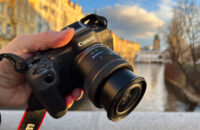Fujifilm X100F is the fourth model in the series that has earned almost cult status. Again, this camera offers excellent image quality, an exceptionally good prime lens (35mm equivalent) and great combination of buttons and dials allowing fantastic degree of control. Yes, it all was present with the previous model, but Fujifilm X100F takes it all much further and despite high price, is a great camera for photographers-connoisseurs.
I am trying to avoid the wording “cult camera”, as it usually belongs among tools of of advertising and marketing writers. So I’m trying not to overuse it – yet here, it fits: Fujifilm X100F simply deserves the title of cult camera.

This series (X100, X100S, X100T) has been for many years a favorite of experienced photographers looking for something small, easy-to-use, and, well, perfect. The four generations of these cameras (the first one appeared in 2011) can be found in the pockets of street photographers, travelers, or simply those wanting to have a great backup (supplementary) camera for its “huge” DSLR.
Of course, it’s not a camera for everyone and I am personally not recommending it to beginner photographers who would find it hard to use its full potential. Work with a prime lens can be tough and requires a fair amount of knowledge about composition. But for those at least slightly advanced, the choice of this camera just make perfect sense – despite its quite high price tag.
During testing, I really enjoyed the Fujifilm X100F and some my uncertainties I had from testing the latest Fujifilm models disappeared (more on that below).
Fujifilm X100F and fantastic lens
I’m going to start a little unsystematically – by stressing what really makes the camera unique and exceptional… Yes, you’d guessed: it is the lens which is just fantastic and moves the entire camera to the zone of excellence, where the experienced photographers must really find it tempting at least…

The lens gives really exciting, breathtaking pictures that are perfectly sharp even the lowest aperture (2) and, at the same times, creates really lovely bokeh.
You can best evaluate the results from the photos on this page, I played with my camera one afternoon in Prague, and then for a few days on a journalistic trip to the Austrian Hotel Puradies in Leogang …
I think that from these photos, it is possible to quickly see what is most important for this camera: just perfect sharpness, ability to work with low depth of field and nice bokeh. Of course, all this works out together with new sensor and great “film simulations” trying (mostly successfully) to imitate old good slide and film materials made by Fuji decade(s) ago…
It should mention that I am personally used to a slightly wider lens. Mostly, I use 28mm/1.8 on my Canon 5D mark iii, and I used to have the same combination on my “analogue” Nikons (Nikon FE, Nikon FM2). Wider shot suits me more than the Fujifilm X100F’s 35 mm … Despite this, I got used to it quite quickly.

Fujifilm X100F – a new sensor in good shape
Of course, we should mention that what makes the most significant step from the last generation of X100 is the new sensor – the new 24 MP chip (the same size like the APS-C DSLR cameras).
In recent months, I have tested all previous cameras with this new sensor (X-PRO2, T-T2, X-T20) and must admit that I was not always excited. Or, to say it in another way, I was not so excited like when testing older models (which helped to built the love-brand reputation of Fujifilm)…
In a nutshell: for many months, I am trying to answer a crucial question (frequent among Fujifilm fans) of whether the new sensors is really exceptional (eg. offering, like in the past, generally slightly better results than competitors), or the new generations provides “only” really top quality comparable to the top models of DSLR, meaning Fujifilm is losing a bit of its exceptionality.
When testing previous models with the new sensor, in some situations, I just did not like the results, they simply did not match my high expectations. So I thought the Fuji magic might be slightly going away.
In this sense, the Fujifilm X100F has rescued the reputation of the company in my eyes – I tested it under a variety of conditions, and did not notice any dubious result. So it’s possible that the company worked on it during the year, and everything has been fine-tuned in firmware changes.

So yes, the Fujifilm X100F is really the “old good Fujifilm” offering something extra, especially thanks to the combination of amazing prime lens + sensor.
At the same time, however, it is not a camera for everybody – for a general use, my advice would probably point to a top end of entry level DSLR which would provide sort of similar results (in the hands of beginners at least) like the lovely Fujifilm X100F.
The funny paradox is that a few years ago, I was telling those who wanted to buy DSLR to look at Fujifilm. Now it’s the opposite: I say to the potential Fujifilm buyers “Do not forget to think about some decent Nikon or Canon, in many case, they would be a more reasonable option.”
So, as I already mentioned, it really is a camera for those who know exactly what they are doing and how to fully use all the fantastic features of this great “machine”.
Fujifilm X100F and great usability
When I saw the first photo of the new camera, I really did not like it – I noticed that Fujifilm X100F has the same ISO setting as X-PRO2: the sensitivity value selector is hidden in the dial controlling the shutter speed.
But, believe or not, is is just a terrible UX mistake – since it is nearly impossible to use it quickly and without losing temper. It dramatically impacts the control of the whole camera (for example, after dark, ISO can hardly be set quickly at all).

Fortunately, Fujifilm apparently under the pressure of angry photographers allowed this nonsense to be bypassed by the software solution – ISO can also be set to the small dial on the front size of the camera.
Which is a dial, by the way, that can also be set to the exposure compensation. All that is really ideal combination for a quick shooting: turn dial, adjust exposure, push the dial, switch it to ISO setting, set the ISO. Great!
By the way, this mysterious letter “C” position on the main exposure correction dial allows you to use exactly this feature. By positioning it on C, you can control the correction (compensation) by the above mentioned small dial.
In short, all the dials and function buttons together make a great combination and rank Fujifilm X100F among the most user-friendly cameras on the market (bypassing, I’d reckon, even legendary usability of Olympus cameras).

One more detail should be noted: yes, this Fujifilm is reasonably quick! Which sounds like a detail, but it is not… Nearly all the previous Fujifilm cameras were often painfully slow.
Now, the general slowness and laziness when awakening from standby mode or focusing is generally gone… Fantastic! Everything works more or less quickly… That’s really a big thing, because some previous models were really almost unusable and therefore irritating.
The Fujifilm X100F on a bike ride
Apart from all this, we also should mention the “banal” fact that the camera is really extraordinary small – which is quite important part of its “image”. I let it go through the “baptism of fire,” when I took Fujifilm X100F with me to a bike ride to the Alps.
Originally, I was planing to hide it in a backpack, the Fujifilm stayed on my neck all the time. And it survived without harm and I barely felt it – which is a parameter more important than it may seem at first glance. Plus the shutter is miraculously silent which can be really useful for travel photographers.

If you’ve read anything about this camera, you might expect me to mention the Fujifilm’s hyped viewfinder, the ability to switch between the digital viewfinder and the normal optical viewfinder, into which various additional information can be projected, etc …
Well, I will not spent much “ink” on it, since, in fact, there is not much use for it. The EVF is so good that I did not really find it tempting to switch if off. Combined with my favorite single focusing point, I just had a camera I really loved a lot.

The Fujifilm X100F – summary
The Fujifilm X100F is a truly cutting-edge tool for experienced photographers accustomed to photographing in reportage style (especially close up and wide-angle). Thanks to its ability to shoot amazing portraits with great bokeh and nice color tones, the combination of great lens and sensor makes it one of the most striking camera in the current market.































Leave a Reply